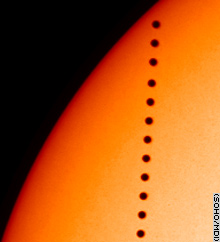|
It's the Astronomy Online non-Blog, or un-Blog.
Everyone has a blog now and since I am no follower of trends, I decided to merge the blog with the website. And I don't want to neglect the website in favor of posting on the blog.
These are the pages that were on the blog of old:
- Home
- Archive (Index of Pages)
- Me
- Current Trends
- Links
- Soho Live
Links:
Google Maps - Mars
Google Maps - Moon
HiRISE
HiRISE - MRO Imaging
Mac Singularity
Meade4M
Slackerpedia Galactica
Software for the Mac
Starry Night Online
Venus Maps
More Favorites:


































Thank you for visiting!
|
|
 |
|
Transit of Mercury - November 8, 2006:
On May 7, 2003 a transit of Mercury occurred. The next transit will occur on November 8, 2006. Across the disk of the sun, Mercury appeared as a tiny black dot only 1/200th the diameter of the Sun. Because of Mercury's rapid orbit, its motion across the disk of the Sun over time is apparent. With the proper equipment, it is possible to image the transit - like the images below.

Mercury Transit - 2003
IMAGE CREDIT: CNN
A telescope with a specialized solar filter, which is placed over the objective (front) lens, will allow safe viewing and imaging of the transit. Filters that fit on the eyepiece only should never be used. Direct viewing with the eye or telescope without proper filters will cause permanent eye damage (a central blind spot called "Solar Retinopathy").

Mercury Transit - 2003
IMAGE CREDIT: Dave McCracken
Because of the small size of the transiting disk, there will not be an apparent drop in brightness. In fact, if you were completely unaware that a transit is in progress, there will be no sign of the event. A transit of a planet offers unique scientific opportunity. For example, a transit can give us clues to the properties of the solar atmosphere. In addition, atmospheres of planets (Mercury has no significant atmosphere) can be studied using spectroscopy by subtracting the known spectra of the Sun (or other star). This is important for the study of exoplanets - atmospheres can be detected and its composition documented. Transits are also used in detecting exoplanets as there is a photometrically visible drop in brightness. Planets with a mass greater than Jupiter can result in a drop in stellar brightness of about 0.0001 to 0.001 magnitudes.
NASA has an excellent graphic of the transit event on November 8 (below). Those of us lucky enough to live on (or near) the west coast of the United States will get to see the event in its entirety. For predicted dates and times from around the world, visit this NASA page.

IMAGE CREDIT: NASA
Transits of Mercury (and Venus) are very rare due to orbital velocities of the inner planets as well as orbital inclinations. If you miss this event, the next transit of Mercury will occur on May 9, 2016. The next transit of Venus will be on June 6, 2012. For this event, I have ordered a special hydrogen-alpha telescope - the PST made by Coronado - to image the transit. Look for these images after November 8 - weather permitting.
More information:
Solar SafetyMercury
NASA 2006 Mercury Transit
NASA 2003 Mercury Transit
SOHO 2003 Transit
Next Post | Previous Post | Back to Top
|
|

